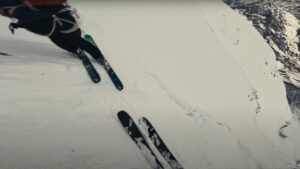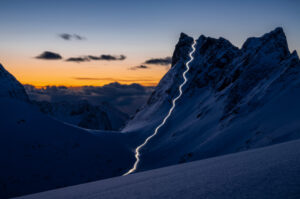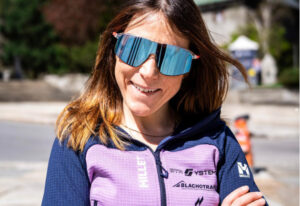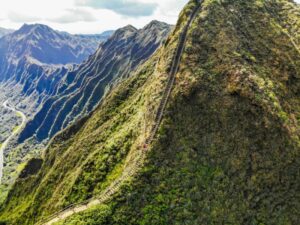On February 14, Igor Magnovsky began a solo ski tour through the Carpathian Mountains in western Ukraine. If he completes the 350km crossing, the 29-year-old will be the first to do so in winter.
The rolling Carpathian Mountains span 1,500km through eight European countries. Although they peak at 2,655m, the highest mountain in the Ukrainian portion, Hoverla, is 2,061m, with a prominence of just over 700m. Magnosky’s trek is less about high alpine than it is about traveling through what is arguably the loveliest part of his country in winter.
Starting at Uzhotsky Lane on the Polish border, his route wanders southeast along the full arc of Ukraine’s Carpathian Mountains to the village of Sarata, on the Romanian border. He hopes to complete the journey in one month; at any rate, he must finish it by March 21 to claim a winter crossing.

The route. Photo: Igor Magnovsky
As a child, Magnovsky went with his parents to the Carpathian and Crimean Mountains. As a student, he spent weekends and holidays exploring the Carpathians on his own. A geologist by trade, he has specialized in speleology and first explored the caves in the Carpathians two years ago.
He has had this trip in mind for about 10 years. Inspired by the books of Roald Amundsen and Reinhold Messner, Magnovsky dreamed of doing a winter expedition in his native mountains. He spent years honing his ski-mountaineering skills and has even worked as a mountain guide in the Caucasus, so he knows how to deal with winter temperatures.

Magnovsky and his kit. Photo: Igor Magnovsky
Magnovsky is taking a fast and light approach. To keep his backpack as light as possible (15kg or less), he has left caches of food and fuel along the route and uses a bivi-awning that weighs only 300g rather than a full tent. He is also prepared to build snow caves or sleep in the open.
Moving quickly also gives him more time for filming and photography. He hopes to turn his journey into a film.
At first, Magnovsky’s main challenge was deep snow, but it improved on the third day, as he climbed to the top of Staostyn Mountain on the Vododilino-Verkhovyna Ridge. Though the climb was only six kilometres long, the first half was through a forest and the second half brought deep snow. With his skis sinking 20 to 30cm into the powder, he wallowed rather than strode briskly.

The bivi-awning. Photo: Igor Magnovsky
Every night, the temperatures have dropped to around -18˚C. The amount of snow has surprised Magnovsky. “So much snow is rare,” he said.
On Saturday, he attempted to climb Mount Pikui, the highest peak along Verkhovnya Ridge, but it was snowing so heavily that visibility dropped to 10m as the wind whipped. He considered seeking shelter in the forest but the steep slopes and intermittent snow coverage made it too risky. Instead, he spent the night dug into his first snow cave of the expedition. “I dug it for about 1.5 hours. It turned out not the most successful type [of cave],” he admitted.

The first snow cave — snow grotto? — of the expedition. Photo: Igor Magnovsky






